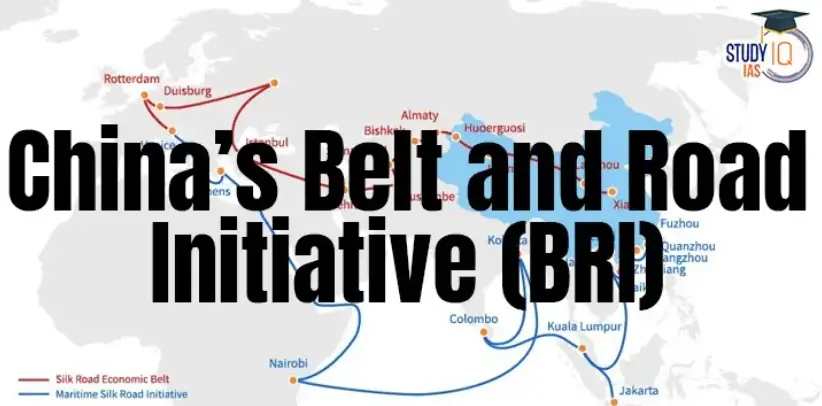The Chinas Belt and Road Initiative (BRI), formerly known as One Belt One Road (OBOR) initiative, is a global infrastructure development strategy adopted by the China in 2013 to invest in nearly 150 countries and international organizations.
Aim of Chinas Belt and Road Initiative (BRI): Build a trade, investment, and infrastructure network connecting Asia with Europe and Africa along the ancient trade routes.
Routes of Chinas Belt and Road Initiative (BRI):
New Silk Road Economic Belt: It encompasses trade and investment hubs to the north of China; by reaching out to Eurasia including a link via Myanmar to India.
Maritime Silk Road: It begins via the South China Sea going towards Indo-China, South-East Asia and then around the Indian Ocean thus reaching Africa and Europe.
China-Pakistan Economic Corridor (CPEC): It is a 3,000-km long route of infrastructure projects connecting China’s northwest Xinjiang Uygur Autonomous Region and the Gwadar Port in the western province of Baluchistan in Pakistan.
Significance of Chinas Belt and Road Initiative (BRI):
Chinas Belt and Road Initiative (BRI) was meant to announce China’s arrival on the world stage as a true global economic power.
It will develop new markets for China’s massive manufacturing sector.
It will put forward China as a maritime power in the South China Sea and the Indian Ocean.
Promotion of Chinese-led financial institutions like the Asian Infrastructure Investment Bank.
Development of poorer western provinces of China, especially Xinjiang.
Access to European markets for Chinese goods.
Creation of an energy route from the Middle East and Africa to reduce dependence on choke points like Strait of Hormuz.
Belt and Road Initiative: Progress
More than 60 countries have now joined BRI agreements with China. Infrastructure projects under the initiative is planned or are under construction in Asia, Africa, Europe, and Latin America.
However, in recent years, the BRI seems to have experienced a slow down as annual Chinese lending to countries slimmed from its peak of $125 billion in 2015 to around $50 to 55 billion in 2021.
Investments in giant infrastructure initiatives based in Africa have also declined substantially.
Belt and Road Initiative Challenges
Poor implementation: While Chinese speed in approving loans and starting projects was often attractive, in practice this meant poor coordination and oversight from Chinese authorities and an even poorer selection of projects.
This has resulted in loss of revenue for China and large debt levels for developing countries.
Neglecting interests of local populations: An estimated 89% of contractors in China’s BRI projects happen to be Chinese companies. This means local firms seem to benefit little from these investments.
E.g. BRI’s investments in Gwadar port in Pakistan has enraged local fishing communities who have seen their business drop substantially with no perceivable benefits.
Lack of transparency: The accusations of debt trap diplomacy, the lack of transparency and unreasonable loan conditions have made the scheme extremely unpopular.
E.g. In 2018, Pakistan pulled out from a deal to build Diamer-Bhasha dam with China. The reason cited was strict deal conditions.
Environmental concerns:
A 2017 report by the WWF noted that, as many as 1,739 Important Bird Areas and Key Biodiversity Areas are at risk due to considerable overlap between BRI projects and sensitive environments.
According to a recent study, BRI could potentially introduce more than 800 alien invasive species into several countries along its many routes and developments, threatening their ecosystems.
Separatist movement and ethnic tensions: particularly in Xinjiang province prove to be a primary challenge for the development of BRI.
Also, the regional disparity between the eastern and western regions of China complicates the use of the western region to connect to neighboring countries.
BRI Impact on India
Violation of India’s Sovereignty. The CPEC violates Indian territorial integrity as it passes through Pakistan Occupied Kashmir.
Militarization of India’s Neighbourhood: India’s strategic and national interests are closely linked to peace and stability in the lOR (Indian Ocean Region). However, IOR is witnessing unprecedented militarization due to Chinese support in the form of military technology, fighter aircraft, warships and submarines.
BCIM-EC and North East India. India is also sensitive to the possible security concerns arising out of linking its restive North East to the Yunnan province of China through the BCIM-EC.
The Bangladesh, China, India and Myanmar Economic Corridor (BCIM) is proposed as part of BRI in 2015.
Security Challenge to India and Indian Shipping: The BRI and CPEC will likely lead to increased shipping congestion in the lOR, thereby posing security challenge to India, Indian shipping and complicating its Maritime Domain Awareness.
Preparing for IAS? And searching the best UPSC coaching classes, So for you, StudyIQ UPSC Live Foundation Batch 6 is the best for your UPSC exam preparation, Because This batch of classes is provided by top faculties of India and retired IAS at a very affordable price. And Our “UPSC IAS (Pre + Mains) Full LIVE GS Foundation Batch” will aid your preparation in completing your Journey to LBSNAA. This course is meticulously designed to cover the detailed prelims-cum-mains syllabus: UPSC Live Classes








